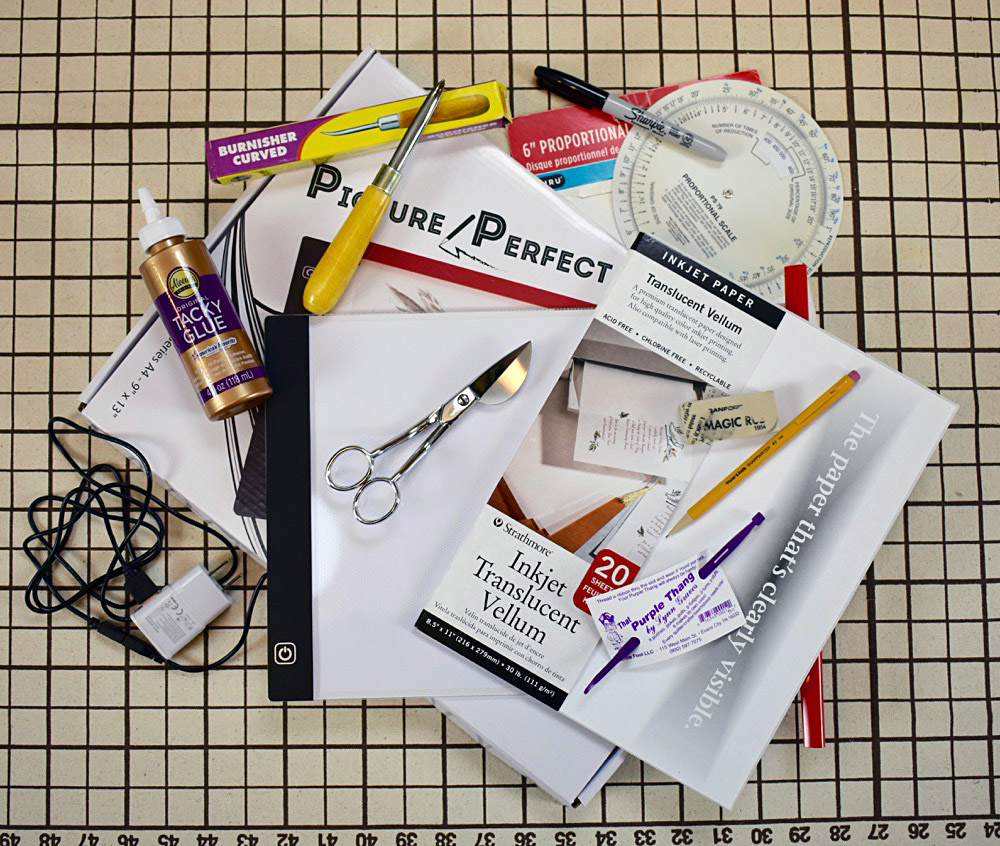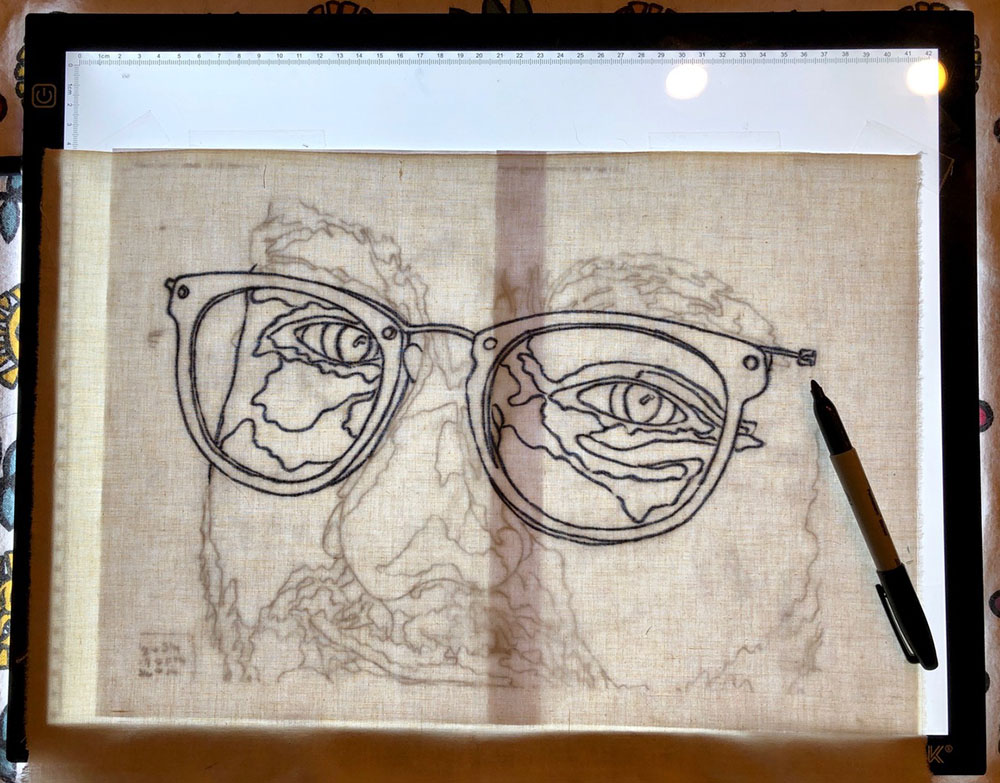THE BASICS
Scissors
I love my "pelican" bladed applique scissors from Gingher. These strange looking scissors (a.k.a. duckbill scissors) are the first tool I turn to for cutting around the printed designs in fabrics. I find them very maneuverable and they allow me to cut very fine and clean. For video demonstrations of me using these applique scissors in different ways for fabric collage, see my updated blog post "Further Thoughts On… Scissors for Fabric Collage."
Other brands besides Gingher that I have tested and like are Maker and Market Applique Pelican Duckbill Blade Scissors and ThreadNanny Duckbill Appliqué Scissors.
Note: For left-handed versions of this model, Havel's Double-Pointed Duckbill 6" Applique Scissors were recommended and covered in my post linked above. And at least one user has recommended Quilters Select Wave Appliqué Scissors, available here.
Here's a short video about how I use these scissors.
For more ways these scissors are helpful, visit my blog post: "Further Thoughts On… Scissors for Fabric Collage."
Glue
For over 25 years now, I have used the Original Aleene's Tacky Glue for my fabric collage quilts. It's non-toxic and dries clear and flexible—not stiff as some other white glues are meant to do. I also feel is has the right "tacky" consistency for fabric collage—not too runny, not too thick—just right. It does not remain tacky, thoroughly dries, doesn't gum up the quilting needle (just a few FAQ's). The Original formula is not their Archival version. I looked it up one time, and the Original formula is less acidic than the fabric itself—so I have no issues with longevity of my artwork as far as this glue goes. And as I said, it's been 25 years, and counting with no adverse affects on those early works. For more on glue read my blog post "Why Glue?"
"Sharpie" Marker
Eventually in the design process there is a time and place for a nice permanent marker, and that's when you're ready to transfer your pattern onto your foundation fabric. I suggest a permanent marker to prevent unfortunate bleed-through incidents when water may be used to loosen errant glue or to smooth a piece of fabric. I also suggest the "regular" sized Sharpie marker to create a nice definitive line as a guide to work from. You get an idea how I use a Sharpie in conjunction with the lightbox in the photo below for transferring my enlarged line-drawing to the foundation fabric.
Pins
I have used regular round-headed quilting pins for holding my bits of fabric in place on my design board forever. They work great. Recently, however, a follower recommended these Magic Pins. She said she has a bit of arthritis. The special shape and grip of the heads of these pins, she said, made them easier and less painful to use. Luckily I don't have arthritis, but I tried them out (and will keep using them), and saw how they could be helpful for those with hand pain.
MAKING A PATTERN
Lightbox
There are different options for tracing your image onto tracing paper—a glass tabletop with a lamp underneath or maybe a nice bright window—but nothing beats the convenience of a light box. I myself have a home-made light box from the last couple decades of the previous century—it does what I need it to do but it's a bit elephantine in both size and weight. I looked into the portable LED light boxes now available—it's a new world out there folks (they're more like a sheet of lit acrylic than a "box"), with many seemingly feather-weight choices available.
I picked these two in particular to try because an electrical adapter is included in the package (a convenience, others have a USB plug only) and they had good reviews for the bit of plug extension that comes off the light box itself (apparently it's a connection that can wear out easily on other models—I'll take their word for it). I gave them a try and they work for me. The 9 x 13 inch size fits the size of the tracing paper I use. Some of you may find the larger size (13 x 17 inches) more convenient for what you do and how you work.
See the larger size in use in the video below with the Proportion Wheel.
Proportion Wheel
A proportion wheel is a tool to figure percentages in either enlarging or reducing something. In my case, I use it figure out what percentage is needed to enlarge my original traced image to create the final desired size of my pattern. My proportion wheel is another hold-over from my college years (along with the Burnishing Tool) and I take pleasure in still using it. You can also figure out enlargement percentages using a math formula, but you'll have to look that one up yourself. Or, I'm told, there's an app for that. Or you can just tell your copy center person what final size you need and let them figure it out. So, this tool is not necessary for most people, but students ask when they see me using it, so here it is. Besides, it is kind of fun to use.
The video below gives a demo of the Proportion Wheel. It also shows the Lightbox listed above.
Tracing Paper (Vellum)
Not all tracing paper is created equal. From way back in my college days, I've used tracing vellum for sketching and designing. It has a nicely textured yet smooth surface that takes a nice sharp pencil line, and erases easily too for those minor (or major) adjustments. I use vellum when I make tracings from photos which I then enlarge to my final image size. Read about creating your own traced design in this blog post "Making a Pattern for Fabric Collage."
Mechanical Pencil
A nice sharp point on a plain ol' pencil gives the best line when tracing your image onto tracing paper—a mechanical pencil means you don't have to keep sharpening it. After using different brands of mechanical pencils through the years, I've settled on this maker as my favorite. You wouldn't think there'd be a difference, but somehow there is.
I always use a pencil line as opposed to an ultra-fine marker line for my drawings. First of all, a pencil gives a thinner line than a marker does, creating a better and more accurate tracing, essential if you're dealing with details such as facial features on person or creature. Second, you can erase a pencil line to adjust your drawing, I never assume I'll get a line right on the first pass. And third, when the drawing is eventually enlarged, the thinner pencil line is more "readable" than an enlarged marker line is.
Eraser
Eventually, I wear out the erasers on the end of my pencils before the lead runs out. If you're the same, here's an eraser I particularly like—it does a nice and neat job.
SUNDRIES
Tweezers
I don't use these myself—I prefer to use my fingers—but some students use this tool or one like it to get into tight places with tiny pieces of fabric. This tool was first recommended by student Kaye Burns, who appears in the video below. Read about how she uses the tweezers and other tips from advanced students here.
Purple Thang
I use my fingers to apply glue—mostly 'cause I always know where they are. However, for those who prefer to keep their fingers clean—or may have trouble getting the glue to the right spot—my students have found Purple Thangs effective. Aside from their amusing name, this tool is meant to be a stiletto and a 1/4 inch measuring tool, but it also works great as a glue applicator. Of course, you can also use coffee stirrers, toothpicks, and so on. Joanne Hannon Shaw demonstrates the use of the Purple Thang in the video.
Burnishing Tool (AKA Safety Pin Closer-Upper)
In my college days, a burnishing tool was a necessity in graphic design classes. Years later, in desperation to save wear and tear on my fingernails, I realized I could re-purpose it to close the safety pins I use to baste my quilts prior to quilting. I hook the curved point under the tips of the safety pins to pull them up into the socket. I demonstrate how I use this tool below, and again in my blog post "Free-Motion Quilting on Fabric Collage Quilts."
Netting, Sheers, Tulle
These are the types of fabrics that I use for adding fun, shiny, sparkly bits to my fabric collage images. I will often use darker sheers to emphasize shadows, while the lighter colored, sparkly ones I use for highlights. Sometimes I use a thin tulle over the entire collage to achieve a certain look or to make the piece easier to quilt. Almost always I pick up my variety of sheer fabrics at stores such as Jo-Ann Fabrics, either locally or as I travel around. But for quantity or convenience, I've found some online. I'll let you do the searching since there are so many to choose from. For information on how I use these specialty fabrics, visit my blog posts: "To Tulle or Not to Tulle" and "Using Sheer, Netting, and other Semi-Transparent Fabrics."
INSPIRATION
Books
I draw inspiration from this book by Anne Lamott, though written for writers, it is a good source fortification for any type of creativity. Lamott's generosity and good humor will help you start or keep going on a project. To read about how I use this book in class, see my blog post "Bird by Bird: How I Use a Book on Writing to Teach Fabric Collage."
When I'm working in my studio, I often choose to listen to audio books. I have a few favorites that deal with creativity and how to get yourself motivated and inspired. I find that every time I listen to one of these books I get something a little different out of them. I'm going to list a few in case you're interested in checking them out for yourself. These are all available in other formats as well:
Big Magic by Elizabeth Gilbert
The War of Art by Steven Pressfield
The Creative Habit by Twyla Tharp

